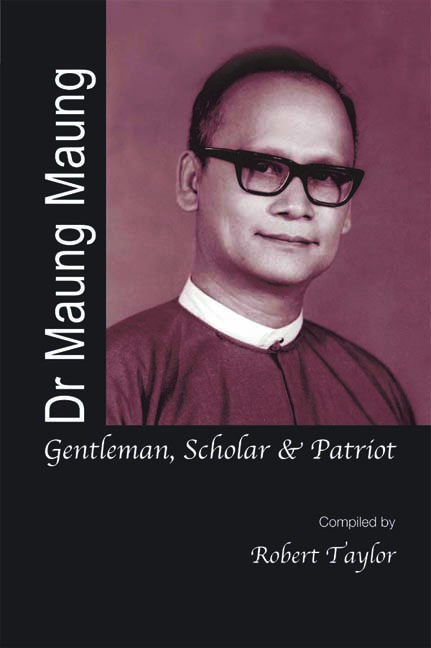Book contents
- Frontmatter
- Epigraph
- Contents
- Preface
- Acknowledgements
- Section I Dr Maung Maung: The Life of a Patriot
- Section II Dr Maung Maung's Approach to Life
- Section III Dr Maung Maung and Biography
- Section IV Dr Maung Maung and Travel
- Section V Dr Maung Maung and the Tatmadaw
- Section VI Dr Maung Maung and the Constitutions of Myanmar
- Section VII Dr Maung Maung and the Presidency
- Bibliography of Dr Maung Maung's Writings
- Index
- The Editor
Section II - Dr Maung Maung's Approach to Life
Published online by Cambridge University Press: 21 October 2015
- Frontmatter
- Epigraph
- Contents
- Preface
- Acknowledgements
- Section I Dr Maung Maung: The Life of a Patriot
- Section II Dr Maung Maung's Approach to Life
- Section III Dr Maung Maung and Biography
- Section IV Dr Maung Maung and Travel
- Section V Dr Maung Maung and the Tatmadaw
- Section VI Dr Maung Maung and the Constitutions of Myanmar
- Section VII Dr Maung Maung and the Presidency
- Bibliography of Dr Maung Maung's Writings
- Index
- The Editor
Summary
All but one of the articles reprinted in this section are based on radio talks that Dr Maung Maung gave over the English-language service of Myanmar Athan, the Myanmar government radio station, in 1948 and 1949. Commissioned by U Khin Zaw, the poet “K”, and published at the insistence of U Thant, then head of Information in the government of Prime Minister U Nu, these texts probably were listened to at the time of their original broadcast by relatively few people. The published versions, however, were widely circulated during the 1950s, but have since largely fallen from view.
Dr Maung Maung was still a young man at the time he wrote these articles, not yet having reached a quarter century of life. However, his experience of growing up rapidly in the midst of war and the political upheaval that nationalist politics brought with it in the wake of the war, had clearly given him maturity beyond his years. It is important to remember the historical context in which he was writing. The first article reprinted was broadcast on the 17 June 1948, the last on 31 July 1949. This year-long period saw Myanmar caught up in the civil war that commenced within three months of independence on 4 January 1948.
First the Communist Party of Burma, led by Thakin Than Tun, and joined by large numbers of Myanmar army troops that had Communistleaning officers in charge, as well as members of the para-military People's Volunteer Organization (PVO), went underground and commenced their armed struggle with the government, a war which was not to end for another forty years. They joined other smaller groups, including Thakin Soe's Red Flag Communists and Islamic separatists in northern Rakhine known as Mujahadeen, who had taken up arms against the British and their successors even before independence. Soon the civil war would take on an ethnic caste as Kayin (Karen) troops mutinied and joined with the armed forces of the Kayin National Defence Organisation (KNDO) in a doomed attempt to create a “Karenistan” out of Myanmar territory.
- Type
- Chapter
- Information
- Dr Maung MaungGentleman, Scholar, Patriot, pp. 25 - 60Publisher: ISEAS–Yusof Ishak InstitutePrint publication year: 2008



